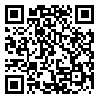Volume 19, Issue 6 (2-2021)
TB 2021, 19(6): 50-62 |
Back to browse issues page
, m.askari@ssu.ac.ir
Abstract: (1609 Views)
Introduction: According to the World Health Organization, Iran has a high level of deaths caused by traffic accidents. Assessment of the death trend and examination of the mortality rate can provide useful information for policy makers to take preventive measures and reduce the casualties caused by these accidents. In this study, the status and trend of mortality due to traffic accidents was investigated over a period of 10 years.
Methods: This descriptive study investigated the trend of deaths from traffic accidents in Iran during 2009-2018. The study data were collected from the Iran Forensic Medicine Organization and the Statistics Center websites. The collected data were analyzed using SPSS version 24 and Microsoft Office Excel 2013 software. The frequency, percentage, annual rate, and independent sample test were run to analyze the data.
Results: On average, 24.1 per 100,000 people were killed in traffic accidents during the study period. A significant difference was found between the number of deaths due to road accidents in men compared to women (p-value <0.05). More than 77 percent of the victims were men and more than 67 percent of the deaths occurred out of urban roads. Semnan, Markazi, and Kerman provinces had the highest mortality rates, while Tehran, Alborz, and Ardabil provinces had the lowest mortality rates during this 10-year period.
Discussion: The death rate from traffic accidents decreased during the study period. Compared to the global average, this rate is not at the desired level, which requires appropriate policy and management to implement effective programs.
Methods: This descriptive study investigated the trend of deaths from traffic accidents in Iran during 2009-2018. The study data were collected from the Iran Forensic Medicine Organization and the Statistics Center websites. The collected data were analyzed using SPSS version 24 and Microsoft Office Excel 2013 software. The frequency, percentage, annual rate, and independent sample test were run to analyze the data.
Results: On average, 24.1 per 100,000 people were killed in traffic accidents during the study period. A significant difference was found between the number of deaths due to road accidents in men compared to women (p-value <0.05). More than 77 percent of the victims were men and more than 67 percent of the deaths occurred out of urban roads. Semnan, Markazi, and Kerman provinces had the highest mortality rates, while Tehran, Alborz, and Ardabil provinces had the lowest mortality rates during this 10-year period.
Discussion: The death rate from traffic accidents decreased during the study period. Compared to the global average, this rate is not at the desired level, which requires appropriate policy and management to implement effective programs.
Type of Study: Research |
Subject:
General
Received: 2020/01/27 | Accepted: 2020/09/28 | Published: 2021/02/28
Received: 2020/01/27 | Accepted: 2020/09/28 | Published: 2021/02/28
| Rights and permissions | |
 |
This work is licensed under a Creative Commons Attribution-NonCommercial 4.0 International License. |




